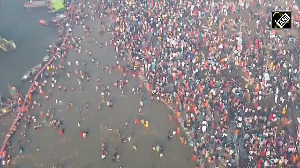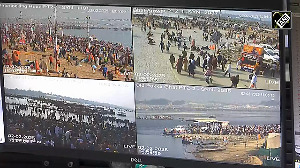As American F-15 fighters sliced through the blue sky of Gwalior in the company of India's Russian-made Sukhoi-30s, they smashed yet another wall of suspicion between the superpower and the South Asian giant.
The air forces of the two countries are holding their first ever joint air combat exercise, which began on February 16, in 40 years in the background of taboos and secrets on both sides.
The exercise kicked off a new chapter in the booming defence relations between the two countries, following a sharp improvement in bilateral ties.
"This has been a beginning for us. We have had no such exposure to the US Air Force," says Air Marshal Ajay Bhavnani, the senior officer of the Central Air Command who is directing the almost two-week long exercise.
Planned over two years back and worked to the smallest detail, the exercise gave the US Air Force its first exposure to the Sukhoi-30s, the latest fighter jet to roll out of the aviation factories of Russia.
Either side is not disclosing the exact capabilities and range of their fighters. Indian pilots and other personnel did get to take a good look at the F-15C Eagles but only at designated times while American pilots got to fly on the trainer version of the Sukhois.
American pilot Captain Dave Skalicky considers himself lucky to be among the first batch of USAF pilots to get to fly in the SU-30. "It is a very good plane, very large, with very good capability," he said.
But the IAF did not allow US personnel access to the SU-30 MKI, the more modern version of the fighter aircraft that contains several key avionics developed indigenously by India.
US gained easy access to Russian-made fighters after the collapse of the communist government there, but the Sukhoi-30 has been made available almost exclusively to India. Even the Russian Air Force got a full squadron of the new generation SU-30s only about a year back.
On the first day, Skalicky and his American buddies, along with their Indian counterparts flew over the Taj Mahal, caught a glimpse of the Himalayas before returning to Gwalior, where India's three Mirage 2000 squadrons are based.
Over the past few days, fighters of the two air forces practiced multi-target interception and attack, protection of high value assets and offensive counter air versus defensive counter air missions.
Sometimes, it was the USAF vs IAF, at other times the rivals comprised pilots from both sides with one group protecting territory against incoming 'enemy' fighters.
Lieutenant Colonel Mark Henkel is leading the six F-15Cs, which are part of an American squadron based in Alaska. His team flew into India from Singapore where they were conducting exercises for two weeks.
The Commanding Officer of the Indian squadron Wing Commander S K Jha said his pilots did not find their US counterparts to be 'much different' on a professional basis "but obviously the US is at the cutting edge of technology."
Air Marshal Bhavnani says the aims and objectives of the exercise have been achieved and a large number of Indian pilots - who fly SU-30s, Mirage 2000s, MiG-21 Bison, MiG-27 and MiG-29 fighters - got unprecedented exposure to the US fighters.
The IAF admits the USAF is technologically advanced but claims its pilots can match the latter's on a tactical basis. Says Wing Commander Jha, whose Battleaxe squadron is believed to one be the finest in India, "Pilots all over the world are the same. Everybody has some mission to achieve and the results are there to see. Everybody trains truthfully for it."






 © 2025
© 2025